Fatigue Damage Assessment of Turbine Runner Blades Considering Sediment Wear
Abstract
:1. Introduction
2. Establishment of a Computational Model for Hydraulic Turbines
2.1. Establishment and Mesh Division of a Hydraulic Model of a Hydro Turbine
2.2. Boundary Condition
2.3. Check for Grid Independence
3. Numerical Calculation of Dynamic Stress on the Runner Blades of a Turbine
3.1. Identification of Wear Locations and Quantification of Wear on Turbine Runner Blades
3.2. Establishment of a Fluid–Structure Interaction Model for Runner Blades and Setting of Boundary Conditions
3.3. Dynamic Numerical Calculation of Runner Blades
4. Fatigue Damage Assessment of Turbine Runner Blades
5. Conclusions
- As the turbine blades continuously wear, there is no significant change in the maximum pressure at the runner inlet, while the negative pressure at the outlet significantly increases. By analyzing the pressure fluctuations on the working and worn surfaces of the blade wear areas, it was found that as wear increases, the pressure fluctuations at the blade tail gradually strengthen, the negative pressure on the worn surface of the blades gradually decreases, and the pressure on the working surface slowly increases. Therefore, as the amount of blade wear increases, it can lead to unstable flow and cavitation near the outlet edge of the blades, which in turn affects the energy conversion efficiency of the runner and reduces the fatigue life of the blades.
- At different stages of blade wear, the maximum stress is always located at the connection area between the blade outlet edge and the lower ring, and the gradient of equivalent stress variation at this position is quite significant, with stress concentration effects also being quite pronounced. Therefore, fatigue damage tends to initiate preferentially in this area, which is entirely consistent with the actual sites of fatigue damage on turbine blades. Moreover, as the blades continue to wear, the overall stress level in the danger zone keeps increasing.
- As the blades continuously wear down, the fatigue damage in the critical areas of the blades increases progressively before they are worn away. The total fatigue damage at the danger points, when considering blade wear, shows a significant increase compared to the fatigue damage at the danger points without considering wear. This has a substantial impact on the calculation of the blade’s fatigue life. Therefore, in basins with high sediment content, the calculation of the fatigue life for hydraulic turbine runners should take into account the effects of sediment wear on the blades.
Author Contributions
Funding
Institutional Review Board Statement
Informed Consent Statement
Data Availability Statement
Acknowledgments
Conflicts of Interest
References
- Unterluggauer, J.; Doujak, E.; Bauer, C. Numerical fatigue analysis of a prototype Francis turbine runner in low-load operation. Int. J. Turbomach. Propuls. Power 2019, 4, 21. [Google Scholar] [CrossRef]
- Chen, X.; Cui, Y.; Zheng, Y. Fatigue crack propagation simulation of vertical centrifugal pump runner using the extended finite element method. Mech. Adv. Mater. Struct. 2023, 1–15. [Google Scholar] [CrossRef]
- Zhu, W.R.; Xiao, R.F.; Yang, W.; Liu, J.; Wang, F.J. Study on stress characteristics of Francis hydraulic turbine runner based on two-way FSI. IOP Conf. Ser. Earth Environ. Sci. 2012, 15, 052016. [Google Scholar] [CrossRef]
- Zhang, L.W.; Tan, J.Z.; Yuan, P. Stress fatigue characteristics analysis of tidal energy horizontal axis turbine blades. J. Ocean. Univ. China (Nat. Sci. Ed.) 2018, 48, 157–164. [Google Scholar]
- Wang, X.; Li, H.; Zhu, F. The calculation of fluid-structure interaction and fatigue analysis for Francis turbine runner. IOP Conf. Ser. Earth Environ. Sci. 2012, 15, 52014. [Google Scholar] [CrossRef]
- Zhang, Y.; Liu, Z.; Li, C.; Wang, X.; Zheng, Y.; Zhang, Z.; Fernandez-Rodriguez, E.; Mahfoud, R.J. Fluid–structure interaction modeling of structural loads and fatigue life analysis of tidal stream turbine. Mathematics 2022, 10, 3674. [Google Scholar] [CrossRef]
- Farhat, M.; Natal, S.; Avellan, F.; Paquet, F.; Lowys, P.Y.; Couston, M. Onboard measurements of pressure and strain fluctuations in a model of low head Francis turbine. Part 1: Instrumentation. In Proceedings of the 21st IAHR Symposium on Hydraulic Machinery and Systems, Lausanne, Switzerland, 9–12 September 2002. [Google Scholar]
- Lowys, P.Y.; Paquet, F.; Couston, M.; Farhat, M.; Natal, S.; Avellan, F. Onboard measurements of pressure and strain fluctuations in a model of low head francis turbine. Part 2: Measurements and preliminary analysis results. In Proceedings of the 21st IAHR Symposium on Hydraulic Machinery and Systems, Lausanne, Switzerland, 9–12 September 2002. [Google Scholar]
- Dorji, U.; Ghomashchi, R. Hydro turbine failure mechanisms: An overview. Eng. Fail. Anal. 2014, 44, 136–147. [Google Scholar] [CrossRef]
- Han, T.T. Research on Structural Damage Diagnosis and Fatigue Life Prediction of Large Fan Blades. Ph.D. Thesis, Qingdao University of Science and Technology, Qingdao, China, 2021; p. 5. [Google Scholar]
- Zhu, L. Research and Application of Fatigue Life Prediction and Reliability Evaluation Method for Structural Components Based on Multi-Factor Correction. Ph.D. Thesis, Southeast University, Nanjing, China, 2018. [Google Scholar]
- Zhao, X. Fatigue Analysis of Francis Runner Blade Based on Fluid-Structure Interaction. Ph.D. Thesis, Xihua University, Chengdu, China, 2016. [Google Scholar]
- Zhao, X.; Dai, C.S. Fatigue life analysis of thrust head of Francis turbine generator set. Shaanxi Electr. Power 2015, 43, 22–24+29. [Google Scholar]
- Zhao, X.; Lai, X.D.; Gou, Q.Q. Fatigue life analysis of upper frame of Francis turbine generator set. Hydropower Energy Sci. 2015, 33, 140–143. [Google Scholar]
- Zhao, X.; Zhu, L.; Lai, X.D. Fatigue life analysis of turbine shaft based on Workbench. China Rural. Water Hydropower 2015, 9, 169–171+174. [Google Scholar]
- Gao, G.Q.; Guo, L.; Zhang, X. Study on fatigue life prediction method of pumped storage unit runner. J. Zhejiang Inst. Water Resour. Hydropower 2016, 28, 17–21. [Google Scholar]
- Huang, J. Study on Fatigue Life of Runner in Zhang He Wan Pumped Storage Unit. Ph.D. Thesis, North China Electric Power University, Beijing, China, 2015. [Google Scholar]
- Zhao, H. Study on Life Prediction of Ultra High Head Impact Turbine Runner Based on Fluid-Structure Interaction. Ph.D. Thesis, Chongqing University of Science and Technology, Chongqing, China, 2022; p. 4. [Google Scholar]
- Heng, X. Research on Comprehensive Reliability Assessment Methods for Turbine Runner Blades under Complex Operating Conditions. Ph.D. Thesis, Guangxi University, Nanning, China, 2019; p. 6. [Google Scholar]
- Chen, J.R. Study on the Relationship between River Turbidity at Ying Xiu Bay Hydropower Station and Sediment Wear of Turbine Runner Blades. Ph.D. Thesis, Xihua University, Chengdu, China, 2021; pp. 8–10. [Google Scholar]
- Pan, J.; Ma, J.; Han, J.; Zhou, Y.; Wu, L.; Zhang, W. Prediction of sediment wear of francis turbine with high head and high sediment content. Front. Energy Res. 2023, 10, 1117606. [Google Scholar] [CrossRef]
- Ding, K. Simulation of Fatigue Life Prediction of Francis Runner Blade Based on Nominal Stress Method. Ph.D. Thesis, Xi’an University of Technology, Xi’an, China, 2011; p. 8. [Google Scholar]
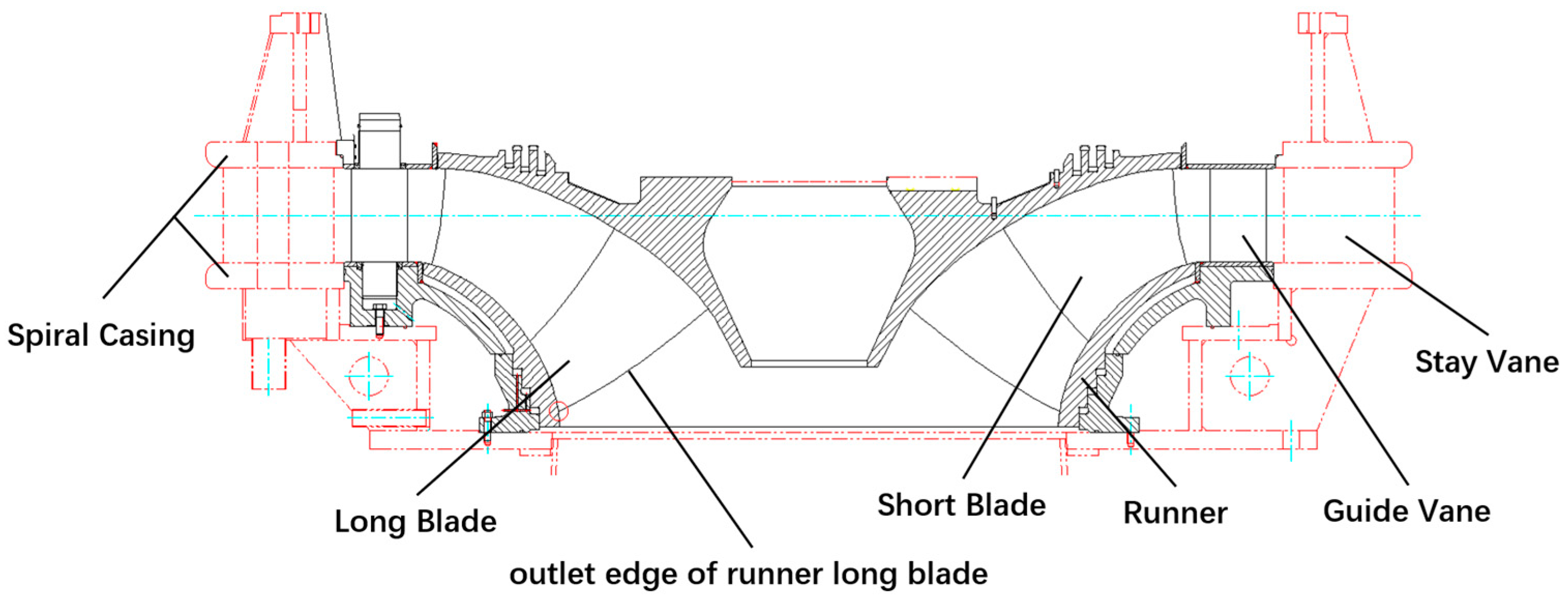
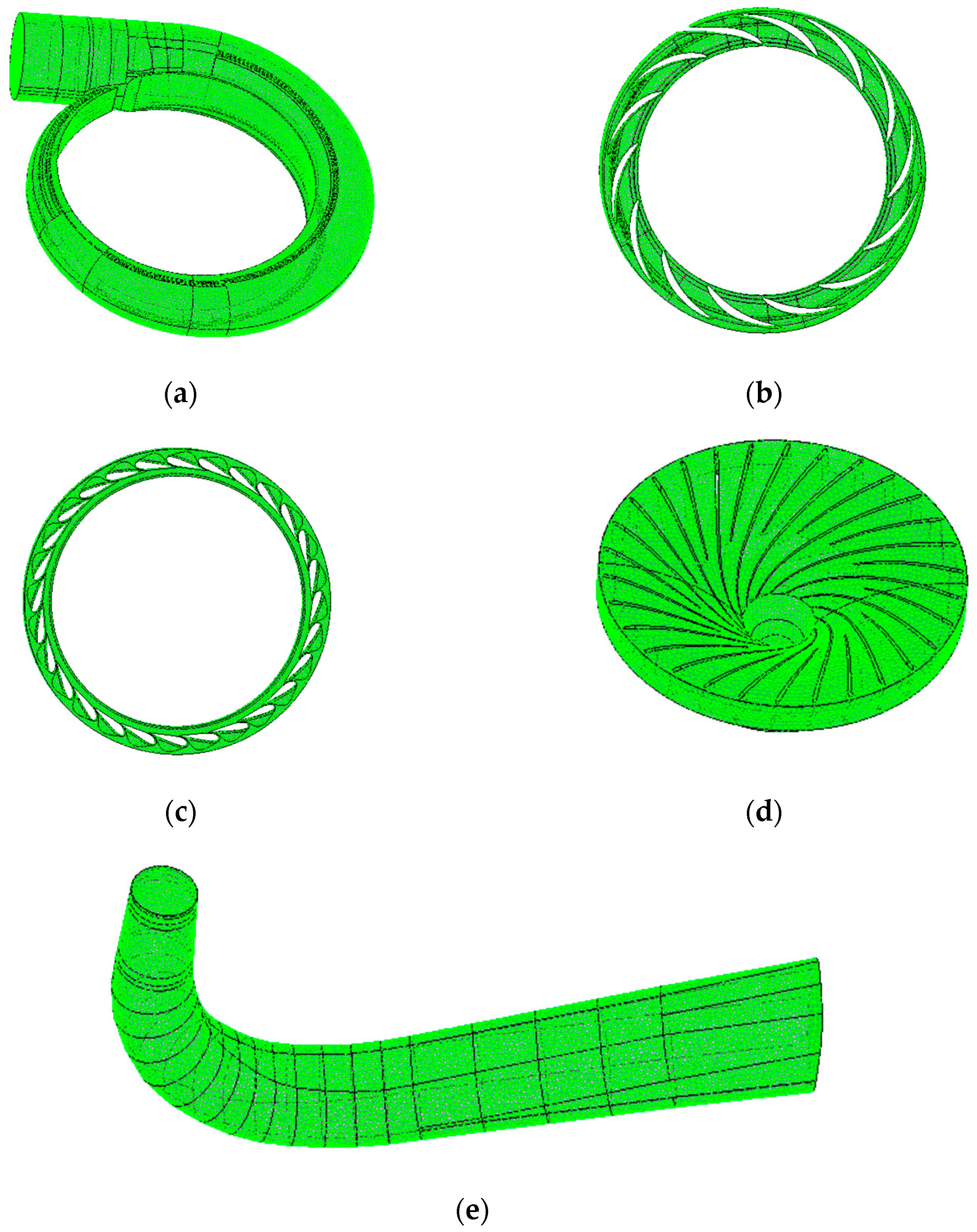
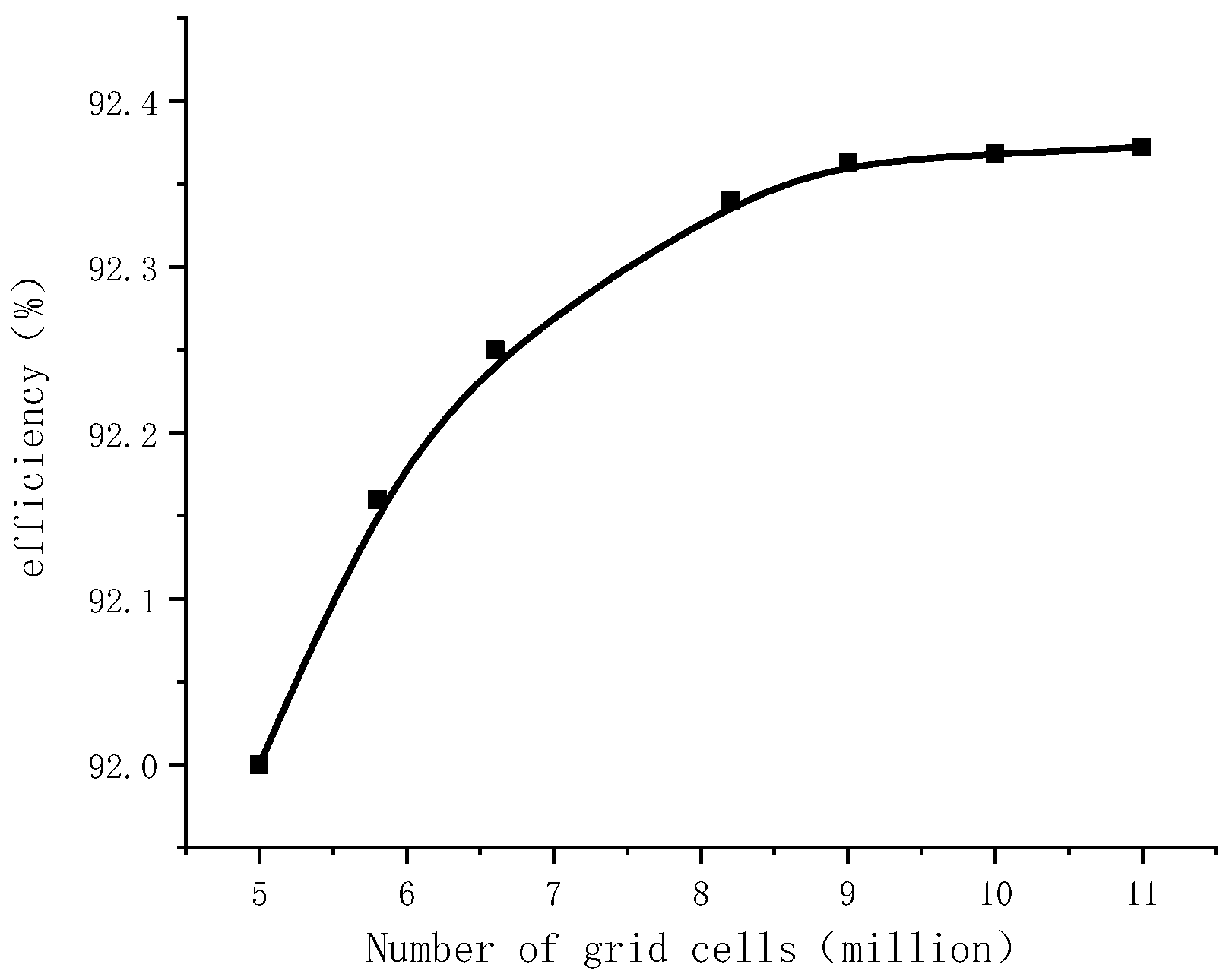
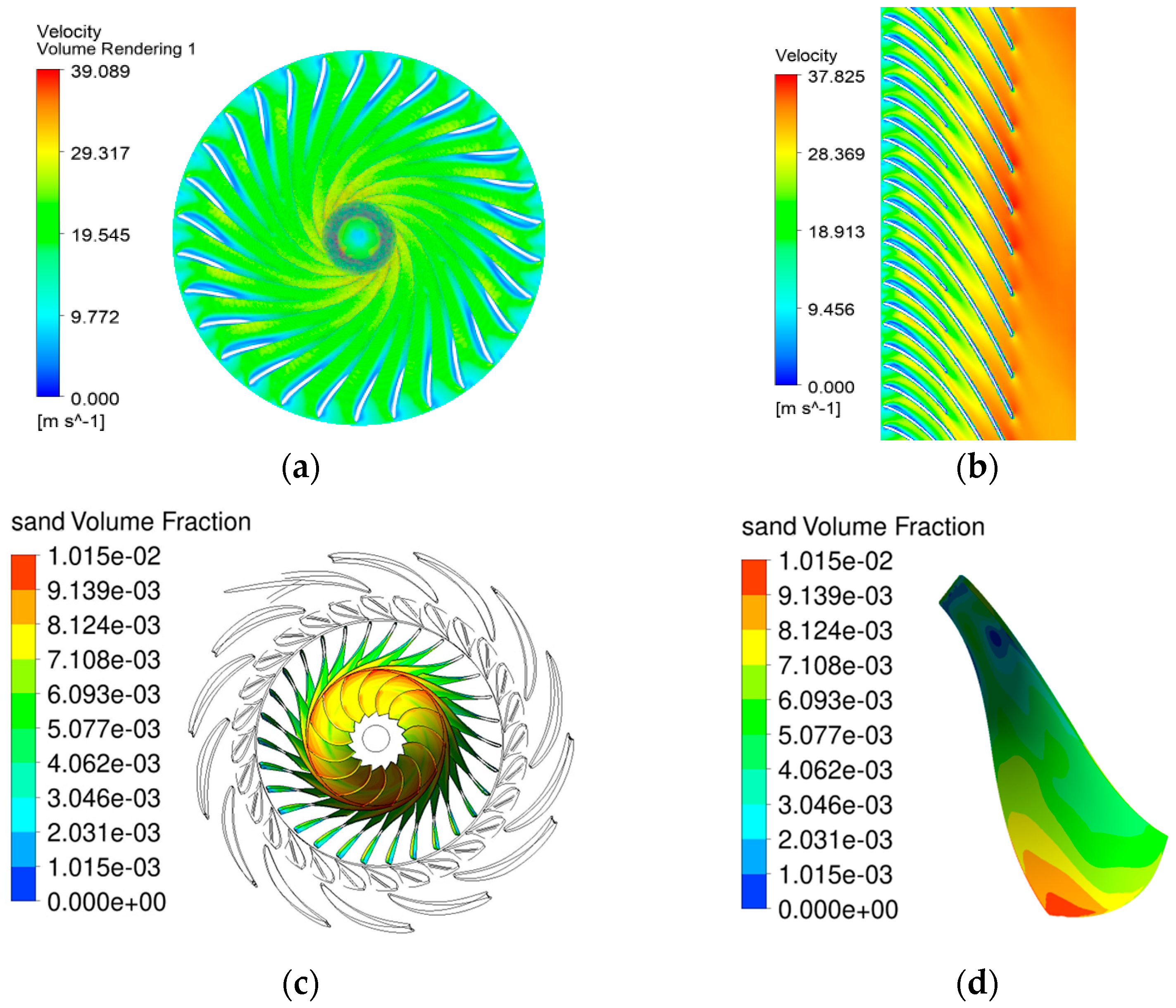
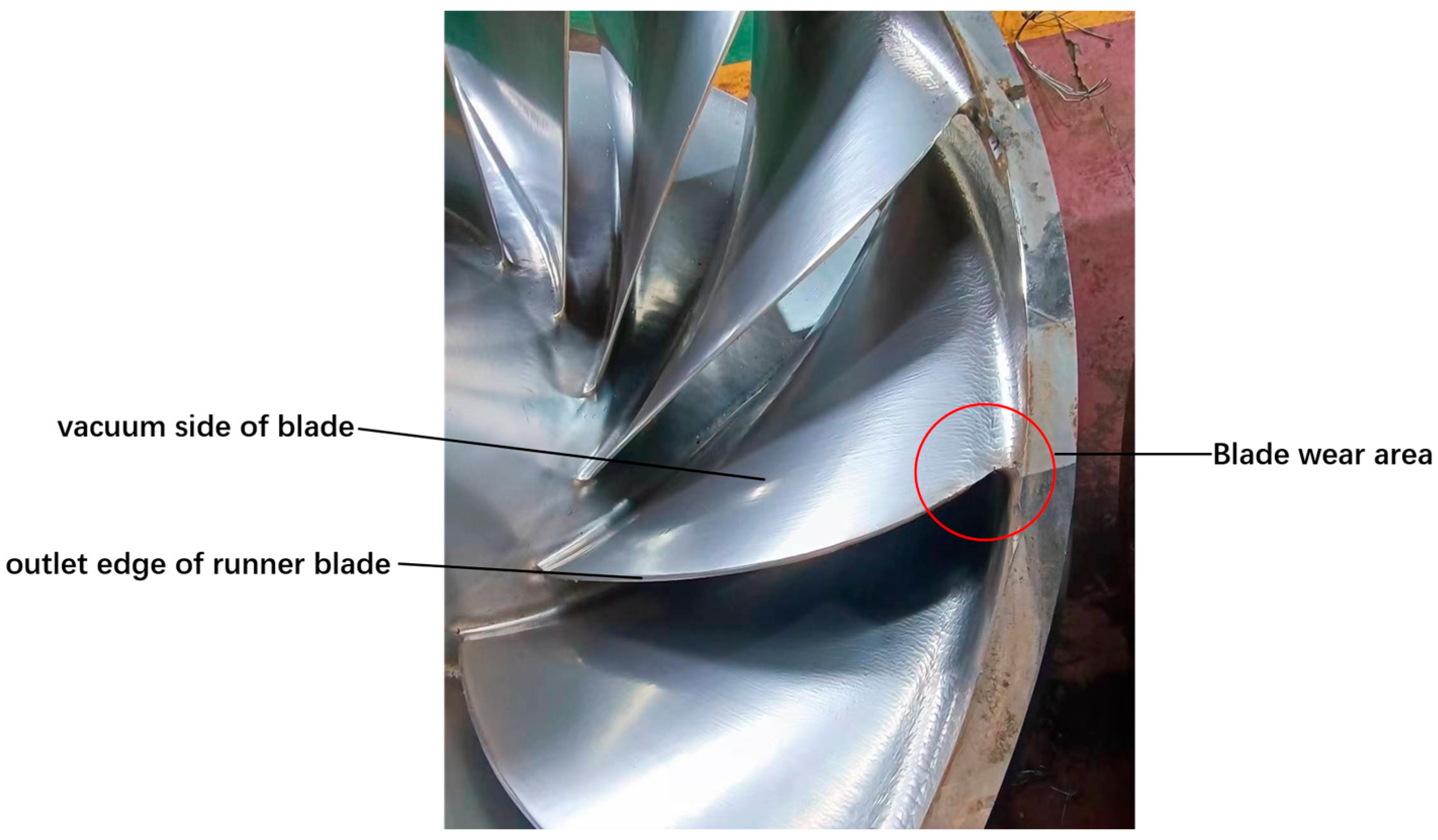
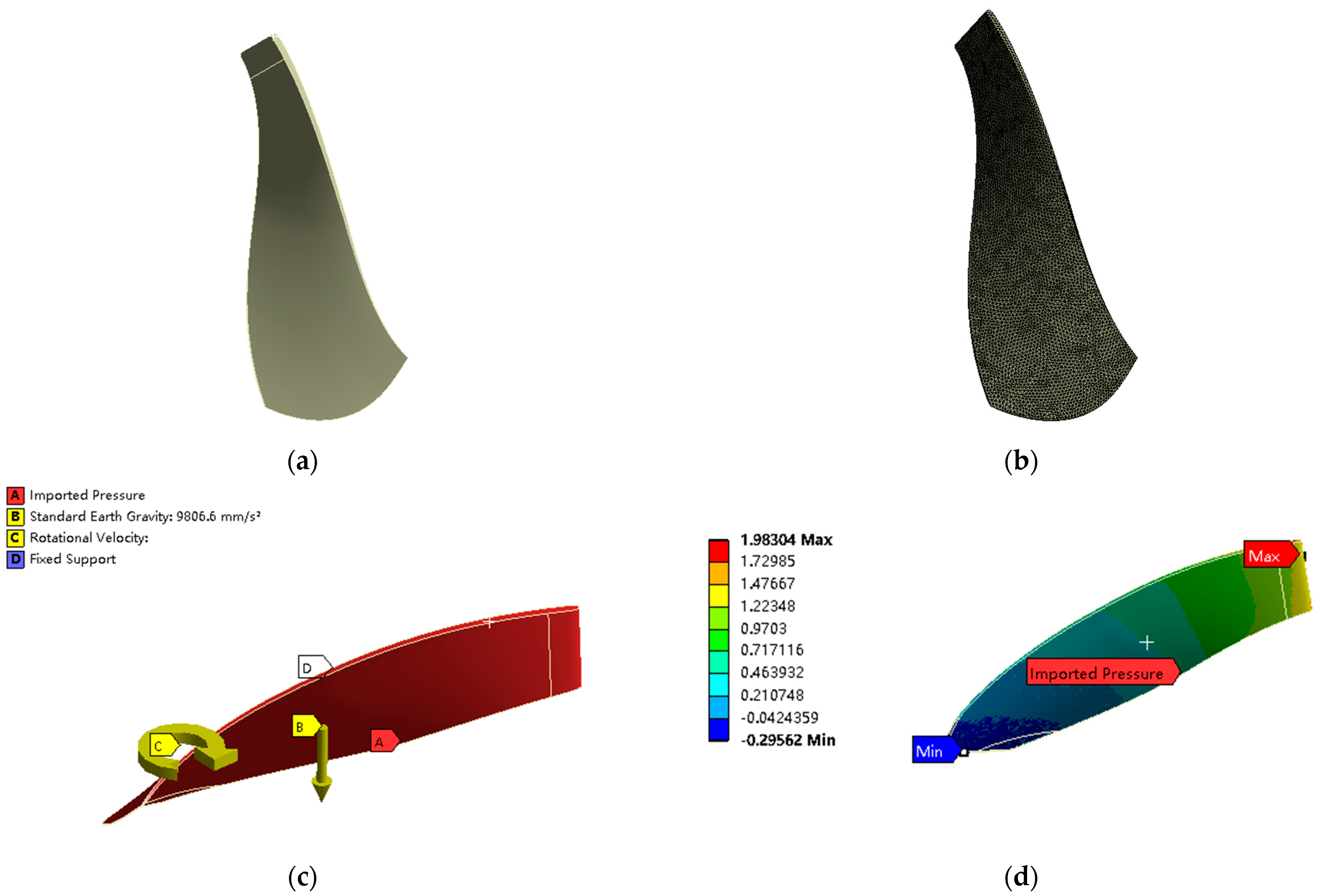
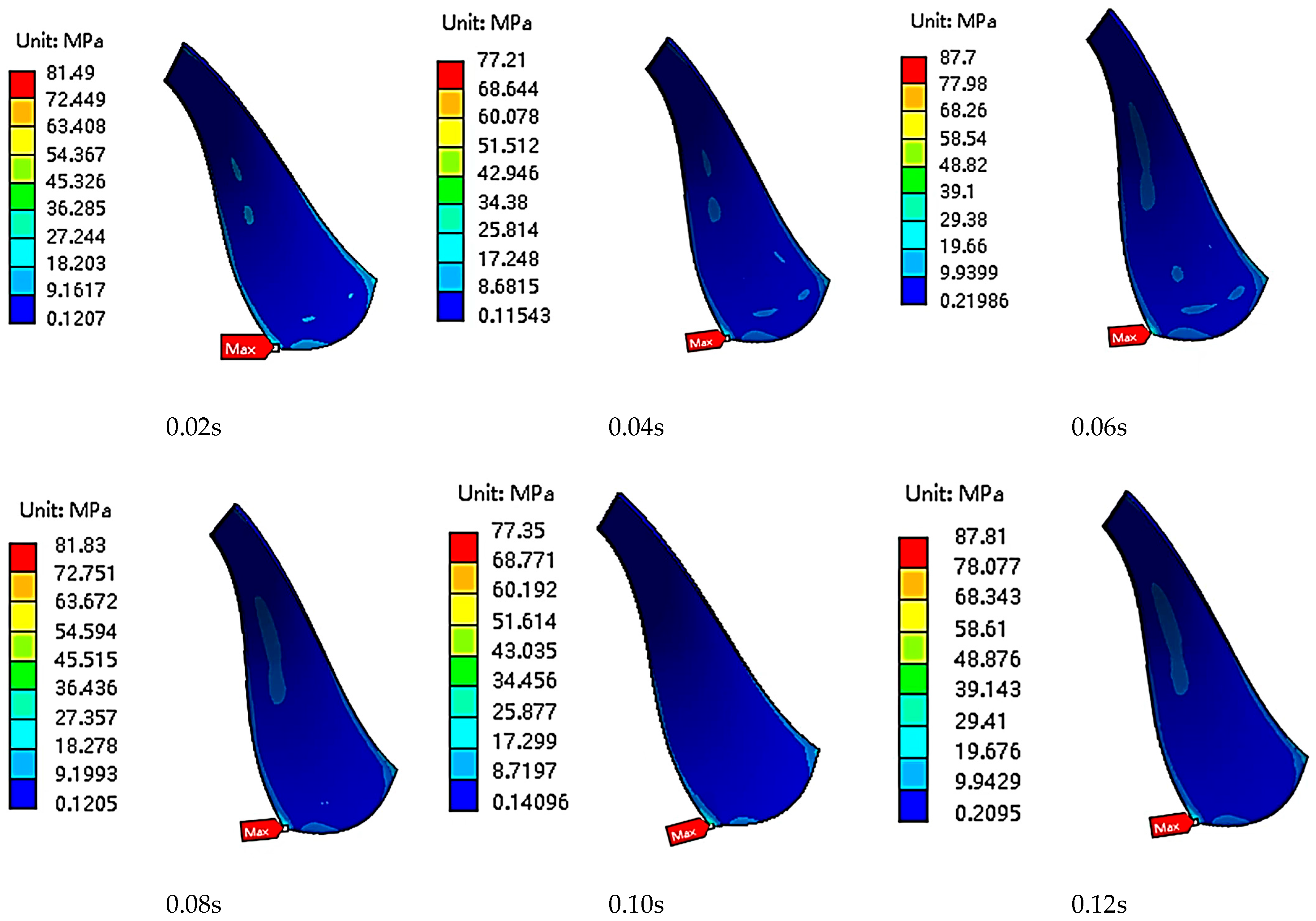
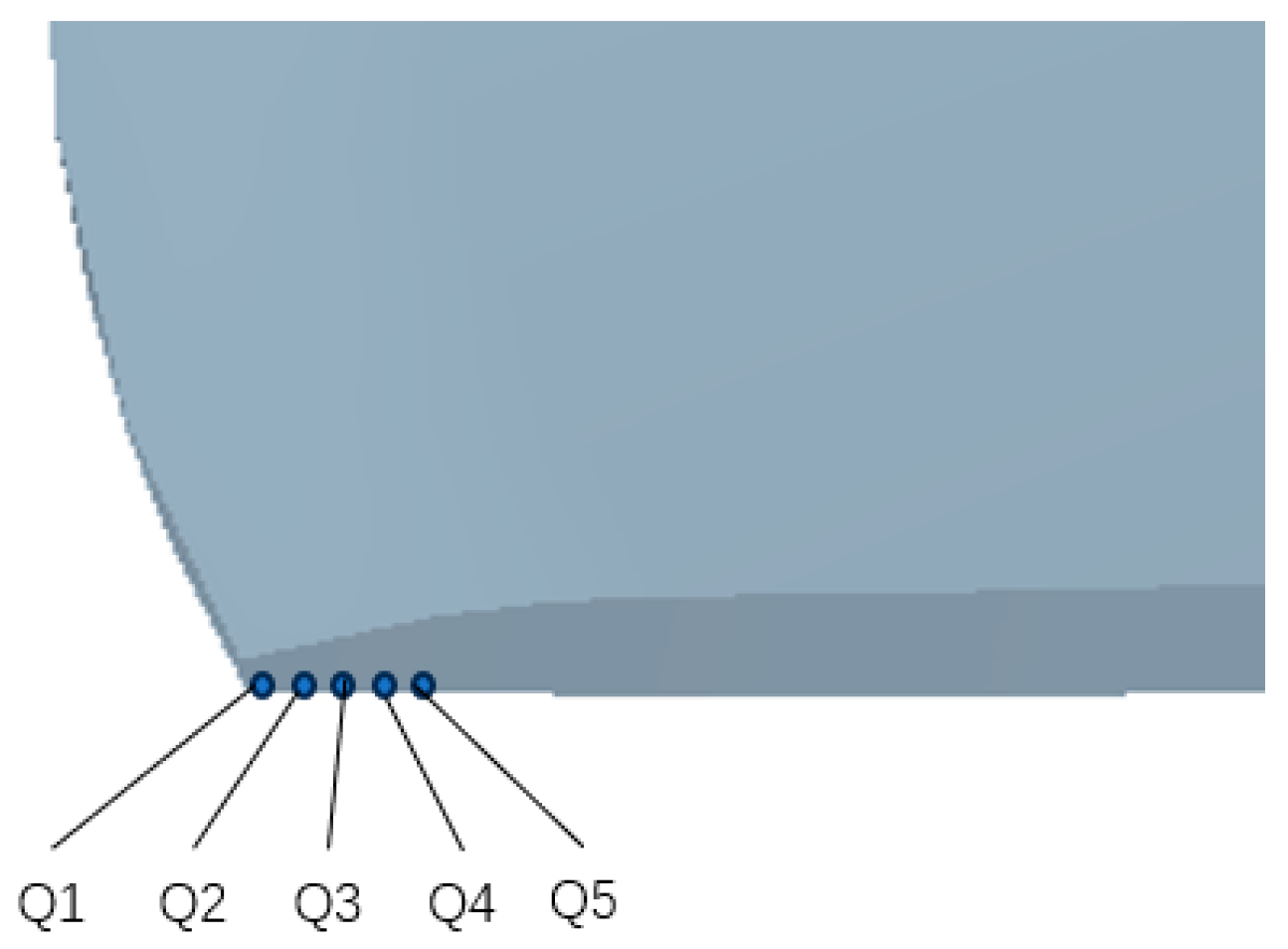

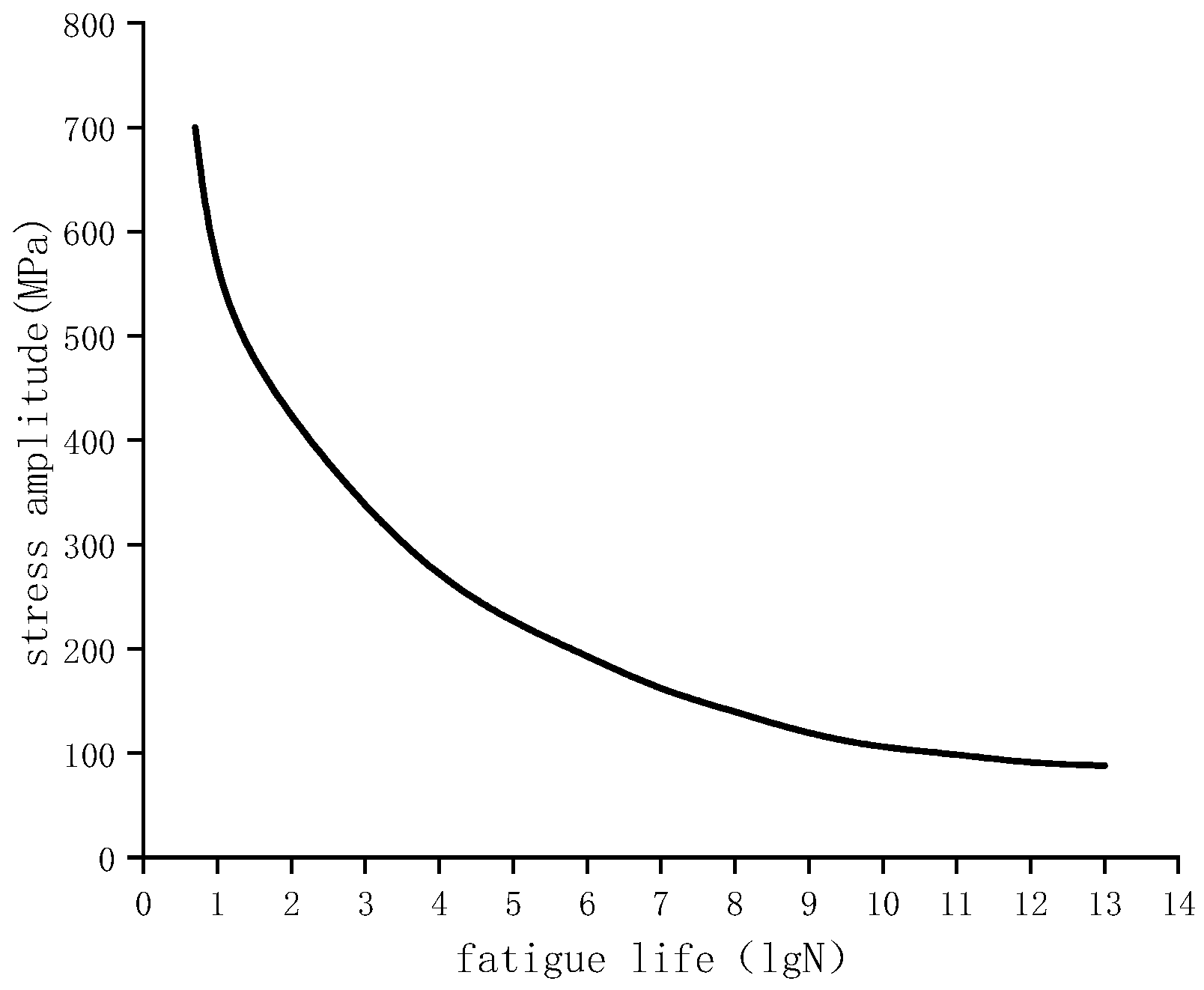

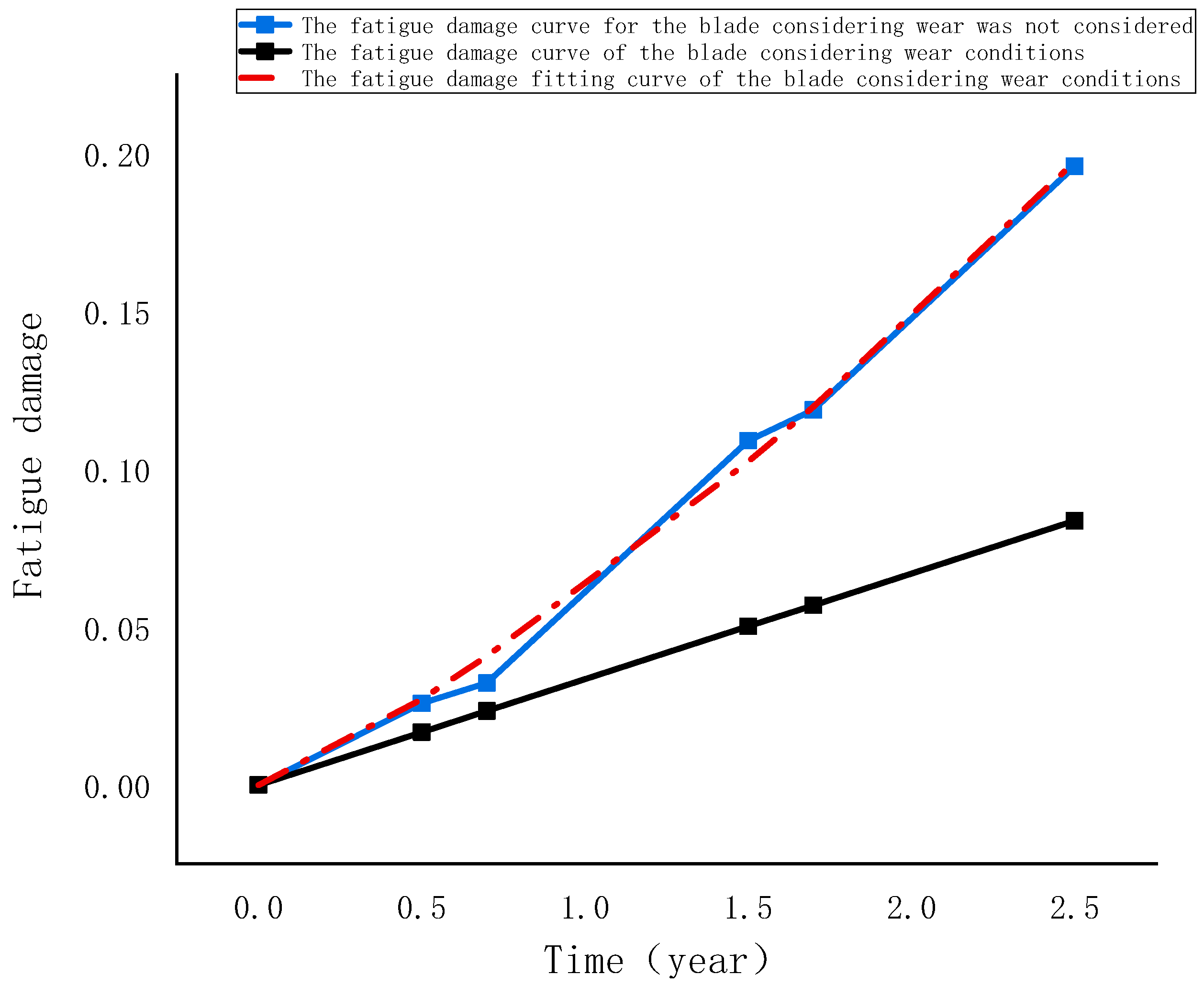
| Name | Units | Parameter |
|---|---|---|
| Mass flow rate | m3/s | 16 |
| Rated speed | Rad/min | 500 |
| Waterhead | m | 282 |
| Runner diameter | m | 2.35 |
| Guide vane height | m | 2.88 |
| Fixed guide vane | Unit | 14 |
| Movable guide vane | Unit | 28 |
| Long blade | Unit | 15 |
| Short blade | Unit | 15 |
| Mesh Cell | Spiral Casing | Guide Vane | Stay Vane | Runner | Draft Tube |
|---|---|---|---|---|---|
| Mesh quantity (million) | 1.78 | 1.45 | 1.34 | 2.7 | 1.74 |
| Quality | 0.48 | 0.52 | 0.5 | 0.47 | 0.55 |
| Degree of Wear | T0 | T1 | T2 | T3 | T4 | T5 |
| Time (month) | 0 | 2 | 4 | 6 | 8 | 10 |
| Wear amount (mm) | 0 | 1.1225 | 2.245 | 3.367 | 4.490 | 5.612 |
| Time | Equivalent Stress at Monitoring Point Q1 (MPa) | |||||
| T0 | T1 | T2 | T3 | T4 | T5 | |
| 0.02 | 81.49 | 91.11 | — | — | — | — |
| 0.04 | 77.21 | 85.21 | — | — | — | — |
| 0.06 | 87.70 | 93.52 | — | — | — | — |
| 0.08 | 81.83 | 90.38 | — | — | — | — |
| 0.10 | 77.35 | 86.16 | — | — | — | — |
| 0.12 | 87.81 | 94.53 | — | — | — | — |
| Time | Equivalent stress at monitoring point Q2 (MPa) | |||||
| T0 | T1 | T2 | T3 | T4 | T5 | |
| 0.02 | 71.42 | 80.75 | 94.48 | — | — | — |
| 0.04 | 68.50 | 77.96 | 89.00 | — | — | — |
| 0.06 | 81.55 | 87.24 | 99.87 | — | — | — |
| 0.08 | 72.67 | 82.73 | 94.80 | — | — | — |
| 0.10 | 70.81 | 79.26 | 89.07 | — | — | — |
| 0.12 | 81.86 | 86.85 | 100.1 | — | — | — |
| Time | Equivalent stress at monitoring point Q3 (MPa) | |||||
| T0 | T1 | T2 | T3 | T4 | T5 | |
| 0.02 | 66.59 | 75.30 | 86.52 | 101.50 | — | — |
| 0.04 | 60.28 | 71.30 | 83.21 | 95.86 | — | — |
| 0.06 | 76.75 | 84.85 | 90.88 | 105.85 | — | — |
| 0.08 | 63.09 | 80.22 | 87.69 | 100.77 | — | — |
| 0.10 | 65.85 | 71.53 | 79.26 | 96.88 | — | — |
| 0.12 | 76.91 | 85.22 | 93.74 | 106.91 | — | — |
| Time | Equivalent stress at monitoring point Q4 (MPa) | |||||
| T0 | T1 | T2 | T3 | T4 | T5 | |
| 0.02 | 59.50 | 62.52 | 79.50 | 90.24 | 113.27 | — |
| 0.04 | 53.81 | 66.77 | 77.38 | 87.20 | 105.08 | — |
| 0.06 | 72.50 | 80.97 | 87.67 | 104.08 | 119.48 | — |
| 0.08 | 60.83 | 62.03 | 83.08 | 95.96 | 113.05 | — |
| 0.10 | 61.44 | 65.75 | 78.91 | 89.9 | 102.16 | — |
| 0.12 | 71.71 | 81.21 | 87.03 | 103.17 | 118.44 | — |
| Time | Equivalent stress at monitoring point Q5 (MPa) | |||||
| T0 | T1 | T2 | T3 | T4 | T5 | |
| 0.02 | 53.56 | 58.41 | 71.58 | 84.41 | 97.32 | 119.78 |
| 0.04 | 49.30 | 52.33 | 65.28 | 77.03 | 91.45 | 108.99 |
| 0.06 | 71.48 | 75.45 | 81.75 | 91.47 | 99.19 | 127.55 |
| 0.08 | 54.62 | 51.62 | 68.09 | 78.91 | 97.56 | 120.16 |
| 0.10 | 60.80 | 51.79 | 70.84 | 83.77 | 91.33 | 109.28 |
| 0.12 | 69.64 | 74.88 | 81.90 | 91.66 | 99.81 | 127.99 |
| T0 | T1 | ||||
|---|---|---|---|---|---|
| Stress Cycle Amplitude (MPa) | Amplitude of Correction (MPa) | Total Damage | Stress Cycle Amplitude (MPa) | Amplitude of Correction (MPa) | Total Damage |
| 2.64 | 57.64 | 0.00670 | 0.28 | 61.15 | 0.01583 |
| 4.73 | 60.37 | 3.256 | 64.12 | ||
| 7.12 | 62.76 | 6.32 | 67.19 | ||
| 9.16 | 64.80 | 9.23 | 70.10 | ||
| 11.54 | 67.18 | 11.68 | 72.55 | ||
| Monitoring Point | Fatigue Damage under Different Blade Wear Degrees | |||||
|---|---|---|---|---|---|---|
| T0 | T1 | T2 | T3 | T4 | T5 | |
| Q1 | 0.00670 | 0.01583 | — | — | — | — |
| Q2 | 0.00463 | 0.00613 | 0.01724 | — | — | — |
| Q3 | 0.00454 | 0.01052 | 0.01562 | 0.02921 | — | — |
| Q4 | 0.00405 | 0.00459 | 0.01316 | 0.0169 | 0.0386 | — |
| Q5 | 0.00246 | 0.00368 | 0.00498 | 0.01305 | 0.02774 | 0.04471 |
| Time (Year) | 0 | 0.5 | 0.7 | 1.5 | 1.7 | 2.5 |
| Irrespective of blade wear Fatigue damage | 0 | 0.01675 | 0.02345 | 0.05025 | 0.05695 | 0.08375 |
| Consider blade wear Fatigue damage | 0 | 0.02588 | 0.03032 | 0.10902 | 0.11880 | 0.19601 |
| Damage growth rate | 0 | 0.54 | 0.29 | 1.17 | 1.09 | 1.34 |
Disclaimer/Publisher’s Note: The statements, opinions and data contained in all publications are solely those of the individual author(s) and contributor(s) and not of MDPI and/or the editor(s). MDPI and/or the editor(s) disclaim responsibility for any injury to people or property resulting from any ideas, methods, instructions or products referred to in the content. |
© 2024 by the authors. Licensee MDPI, Basel, Switzerland. This article is an open access article distributed under the terms and conditions of the Creative Commons Attribution (CC BY) license (https://creativecommons.org/licenses/by/4.0/).
Share and Cite
Chen, H.; Pan, J.; Wang, S.; Ma, J.; Zhang, W. Fatigue Damage Assessment of Turbine Runner Blades Considering Sediment Wear. Appl. Sci. 2024, 14, 4660. https://doi.org/10.3390/app14114660
Chen H, Pan J, Wang S, Ma J, Zhang W. Fatigue Damage Assessment of Turbine Runner Blades Considering Sediment Wear. Applied Sciences. 2024; 14(11):4660. https://doi.org/10.3390/app14114660
Chicago/Turabian StyleChen, Haifeng, Jun Pan, Shuo Wang, Jianfeng Ma, and Weiliang Zhang. 2024. "Fatigue Damage Assessment of Turbine Runner Blades Considering Sediment Wear" Applied Sciences 14, no. 11: 4660. https://doi.org/10.3390/app14114660
APA StyleChen, H., Pan, J., Wang, S., Ma, J., & Zhang, W. (2024). Fatigue Damage Assessment of Turbine Runner Blades Considering Sediment Wear. Applied Sciences, 14(11), 4660. https://doi.org/10.3390/app14114660






